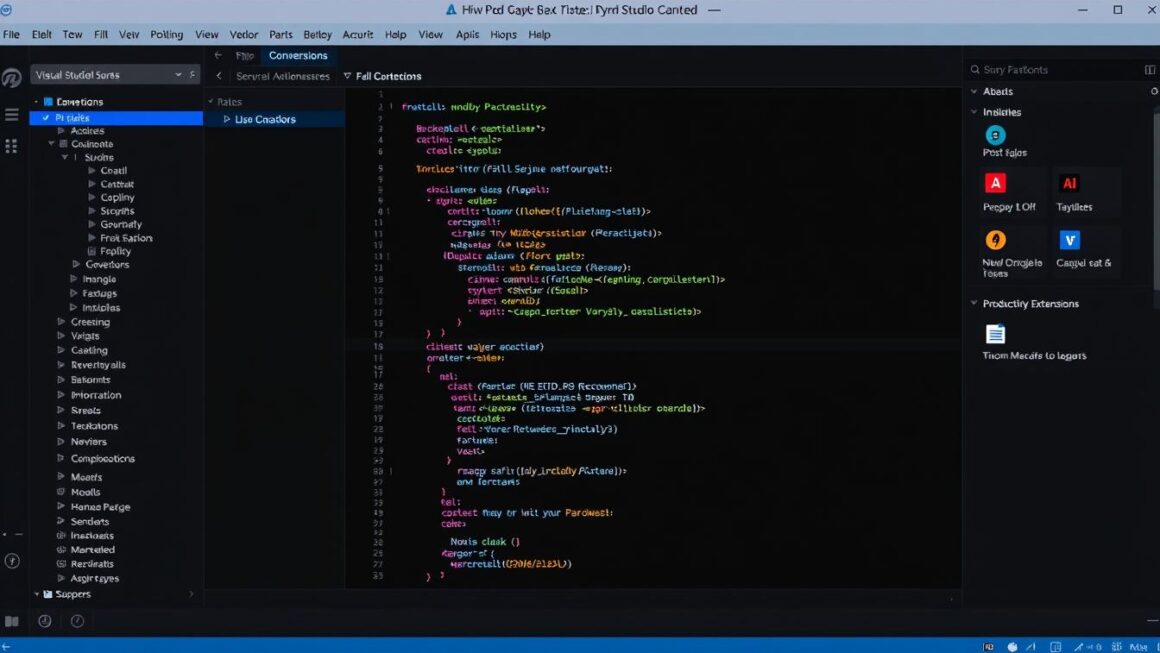Did you know many software defects come from bad code checks? Code reviews are key for making sure our software is top-notch. When developers check each other’s code, we find mistakes early, make code easier to read, and keep it maintainable.
Code reviews are all about working together and sharing knowledge. They let developers learn from each other, talk about the best ways to code, and match their styles. As we face the challenges of coding, making code reviews a priority is vital. It helps us make sure our software is the best it can be.
By focusing on code reviews, we don’t just make our code better. We also build a team that values openness and always wants to get better.
The Hidden Value of Code Reviews
Code reviews do more than just find errors. They help create a team that works well together and keeps getting better. By making code reviews part of our work, we make our code better and our team stronger.
More Than Just Finding Bugs
People often see code reviews as just for finding bugs. But they do so much more. They let developers learn from each other and make sure the code is easy to keep up with. Good code reviews lead to better coding and a unified codebase.
Building Team Knowledge and Cohesion
Code reviews are key to a team’s knowledge and unity. When many team members review the code, everyone knows what’s going on. This teamwork builds a sense of responsibility and teamwork, making the team more effective.
Why You Should Care About Code Reviews (and How to Do Them Right)
Code reviews are more than just finding bugs. They help build a culture of excellence in software development. By adding code reviews to our development process, we gain many benefits. These benefits help our business and our development teams grow.
The Business Case for Reviews
From a business view, code reviews bring big advantages. They help find defects early and make projects run smoother.
Cost of Defects: Early vs. Late Detection
Finding defects early saves a lot of money. Early detection can save up to 10 times the cost of fixing a defect later.
Impact on Project Timelines and Quality
Regular code reviews keep projects on track. They fix issues quickly, avoiding delays. They also make the code better, leading to more reliable software.
The Developer’s Perspective
For developers, code reviews are a great way to grow and reduce stress.
Professional Growth Opportunities
Code reviews give developers constructive feedback. This helps them get better at coding and learn from others.
Reduced Stress and Technical Debt
By fixing issues early and keeping code clean, developers reduce technical debt. This also lowers the stress of dealing with complex code.
The Measurable Benefits of Regular Code Reviews
Regular code reviews bring many benefits to the development process. They help teams find and fix problems early. This leads to better software quality.
Reduced Defect Rates
Code reviews help lower defect rates by catching bugs early. This saves time and money on debugging. Studies show teams with regular reviews have fewer defects in production.
Improved Code Quality Metrics
Code reviews also boost code quality. Teams check their code against standards and best practices. This keeps the software reliable and easy to maintain. Improved code quality metrics come from thorough and regular reviews.
Knowledge Sharing and Skill Development
Regular code reviews also help teams share knowledge and grow skills. Developers learn from each other, creating a culture of learning. This improves individual skills and strengthens the team.
Common Objections to Code Reviews (and Why They’re Wrong)
Many people doubt the value of code reviews. But each of these doubts has its own weaknesses. It’s key to tackle these concerns to see why code reviews are vital in our work.
“We Don’t Have Time”
Some say code reviews slow us down. But the benefits they bring are worth the time spent. They help us find bugs early and make our code better, saving us time later on.
“Our Developers Are Already Experts”
Even skilled developers can learn from code reviews. They offer a chance to share knowledge and spot areas for growth. This teamwork makes our code review process stronger.
“Automated Tests Are Enough”
Automated tests are important, but they can’t replace human checks. Code reviews catch things automated tests might miss, like how easy the code is to read and maintain. Together, they keep our code solid and easy to work with.
Setting Up an Effective Code Review Process
To make code reviews work well, teams need a solid process. A good code review starts with defining clear goals and expectations. This means making review guidelines and setting doable timeframes.
Defining Clear Goals and Expectations
Clear goals are key to keeping everyone in sync during code reviews. It’s important to know what parts of the code to check.
Creating Review Guidelines
We must create guidelines for what makes code good. This includes coding standards, comments, and tests. It helps reviewers give feedback that’s helpful and consistent.
Setting Realistic Timeframes
It’s important to set realistic times for code reviews. We should give enough time for detailed reviews without slowing down development.
Choosing the Right Review Cadence
The frequency of code reviews matters a lot. We need to pick a pace that fits our team, whether it’s daily, weekly, or something else. It should match our workflow.
Selecting Appropriate Tools
The right tools make code reviews smoother. We should pick tools that fit our development setup and support our review schedule and rules. This could include tools for checking code, commenting, and tracking changes.
By thinking about these points, we can create a code review process that boosts our team’s work and makes our code better.
Preparing Code for Review: Best Practices

Before we start the code review, we need to prepare our code well. This step is key for a smooth review and better code quality.
Creating Focused, Manageable Pull Requests
Creating focused, manageable pull requests is important. We should break down big changes into smaller parts. This makes it easier for reviewers to understand and give good feedback.
Our guidelines stress the need for clear pull requests.
Writing Descriptive Commit Messages
Writing clear commit messages is another best practice. These messages should explain the changes made. This helps reviewers focus on the most important parts.
Tools like GitHub or GitLab make it easier to link messages to changes.
Self-Review Techniques
Before we submit our code, we should review it ourselves. This includes using tools to find issues early.
Using Linters and Static Analysis
Linters and static analysis tools find errors and improve code quality. By using these code review tools in our workflow, we can catch many issues before the formal review.
Manual Pre-Review Checklist
A manual checklist is also helpful. It covers important areas like code readability and standards. Going through this checklist ensures our code is ready for review.
The Code Reviewer’s Checklist
A well-structured code review checklist is key for keeping our code quality assurance high. It makes sure our code is strong, easy to work with, and meets our quality standards.
Functionality and Logic Review
When we check code functionality and logic, we must see if it works as it should. We look at both the normal use and what happens in unusual situations.
Edge Case Identification
Finding edge cases is very important. We should think, “What if the input is not what we expect or if the system is under a lot of stress?”
Business Logic Verification
It’s also key to check the business logic. We need to make sure the code follows the business rules right and does so consistently.
Code Style and Readability
Code style and how easy it is to read are just as critical. We should ensure the code meets our coding standards, is well-documented, and is simple to grasp.
Security and Performance Considerations
Lastly, we must think about security and how well the code performs. We look for vulnerabilities, make sure sensitive data is handled right, and check if the code runs well under different loads.
By using this checklist, we make sure our code review is complete and helps improve our code quality assurance.
Giving Constructive Feedback
Constructive feedback is key to a good code review. It helps us improve our code and skills. It’s about creating a space where we can learn from each other and make our code better.
The Art of Tactful Criticism
Giving constructive feedback means being honest but kind. It’s about finding a balance. We should focus on the code, not the person, and use clear, helpful language.
Using the “Praise, Question, Suggest” Model
The “praise, question, suggest” model is great for giving balanced feedback. It makes sure our comments are fair and complete.
Starting with Positive Observations
Start by saying what’s good. This sets a positive tone and shows we appreciate our colleagues’ hard work.
Asking Clarifying Questions
Then, ask questions to understand the coding decisions. This helps us learn from each other and find better solutions.
Offering Specific Improvements
Lastly, suggest specific ways to improve. Be clear and give examples or alternatives when you can.
Focusing on the Code, Not the Coder
It’s important to separate the code from the person who wrote it. This way, we avoid personal biases and make the review process more effective and less stressful.
By using these strategies, we can make our code reviews more productive. This benefits everyone and helps us follow code review best practices.
Receiving and Responding to Review Comments

The code review process doesn’t end with submitting comments. It’s important to know how to receive and respond to them. This part of code reviews is key for code review importance. It affects the code quality and team work.
Maintaining a Growth Mindset
Getting feedback means having a growth mindset. It’s about understanding that comments aim to make the code better, not to criticize. This mindset helps create a culture of learning and growth. It’s a big part of code review guidelines.
When to Push Back (Respectfully)
Sometimes, we might disagree with comments or suggestions. It’s important to know when to respectfully disagree. We should give clear reasons and offer better solutions. This helps solve conflicts and keeps the team’s dialogue positive and helpful.
Learning from Feedback Patterns
Feedback patterns can show us where we need to improve. By noticing and learning from these patterns, we can improve our coding. This makes the code review importance even more significant.
By following these guidelines and being open to feedback, we can improve the code review process. This leads to better code quality and a stronger team.
Code Review Tools and Platforms
Choosing the right code review tool can be tough. But it’s key to making the process smoother. The right tool can make code better, and help teams work together better.
GitHub Pull Requests and Reviews
GitHub’s pull request feature is a top pick for code reviews. It lets developers check code, leave comments, and decide if changes are good. It works well with GitHub’s version control, making it easy for teams using it.
GitLab Merge Requests
GitLab’s merge request feature is also popular. It’s similar to GitHub’s pull requests but is part of a bigger DevOps platform. It lets teams have detailed discussions and reviews.
Specialized Code Review Tools
There are tools beyond GitHub and GitLab for code reviews. These tools have advanced features like detailed analysis and reports.
Crucible and Collaborator
Tools like Crucible and Collaborator offer advanced review features. They include analytics and reporting to help teams improve code quality. They make the review process more efficient.
Integration with CI/CD Pipelines
Many code review tools work with CI/CD pipelines. This integration adds automated testing and feedback. It ensures code changes are reviewed and tested before they’re used.
Measuring the Success of Your Code Review Process
It’s key to measure how well a code review process works. We need to track important signs to see if our reviews are making a difference. This helps us understand the impact on our code quality assurance.
Key Performance Indicators
We should look at both numbers and feedback to measure success. This helps us see how well our reviews are doing.
Quantitative Metrics
Numbers like defect density and review coverage are important. They show us how efficient our reviews are. The time it takes to finish reviews also matters.
Qualitative Feedback
Feedback from developers is just as valuable. It tells us what we can improve on. This feedback adds depth to the numbers we look at.
Continuous Improvement Strategies
To keep our code review process sharp, we need to always be improving. We should check our numbers, listen to feedback, and tweak our process as needed. This way, we can make our reviews better for our team and improve code quality.
Conclusion
Code reviews are key to making our software better. They help us catch mistakes early and share knowledge. This makes our code better and easier to maintain.
Regular code reviews help avoid future problems. They also help our team work better together. This leads to better code and a more collaborative environment.
Using the right tools and giving helpful feedback makes code reviews more effective. As we keep improving, code reviews will stay important. They help us make software that works well and is reliable.



